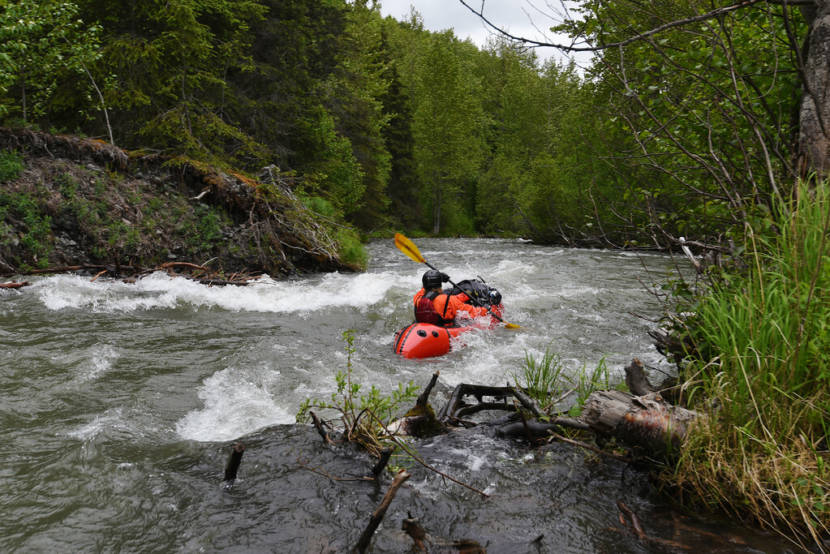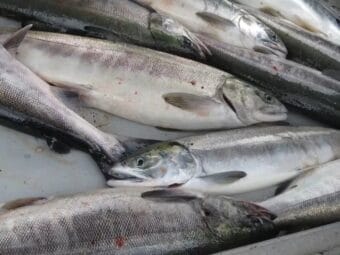
Packrafting is a mode of transportation that, as the name suggests, involves carrying an inflatable boat in a backpack and then deploying it to travel on water.
That can be a short trip to cross part of a lake … or it can mean floating hundreds of river miles and even running rapids.
As more people have gotten into the sport, Alaska adventurer Luc Mehl saw a need to compile safety tips and techniques to share with others.
So, Mehl quit his job and wrote “The Packraft Handbook,” which is illustrated by artist and fellow packrafter Sarah Glaser.
Mehl says packrafting changed his life and that a big reason for writing the book was to help people stay alive while doing it.
Listen:
Read a full transcript with minor edits for clarity.
Luc Mehl: I spent maybe five or six years boating and loving it and getting more and more into whitewater and technical sections of rivers, where the risks are higher if things go wrong.
Then I lost a friend. What really hit me is that we had been cutting the same corners: we weren’t wearing a dry suit on the same river, we hadn’t had formal training, all this stuff. In terms of our decisions, it just felt like that could have been me. And it just pissed me off that he drowned.
That was seven years ago. And that’s the path I’ve been on. I got that instruction, and I liked it so much that I’ve been trained to be an instructor. And so I’ve been teaching for four years. And so that whole process put me in a position to try to get this information out to other people so that maybe they can jump to this point without having to lose a friend first.
Casey Grove: Yeah, that’s really important. To backup, packrafts can be a little bit more susceptible to these things, because they’re designed to be light so that you can carry them in your backpack, but they also inflate and you can use them to run down a river. But it’s not like a hard kayak. So how is it different than a kayak or a canoe that somebody might be used to?
Luc Mehl: The answer to that is really about the hull design. So the hull is the part that displaces water. Packrafts sit perfectly flat in the water, and so in terms of stability, that means they have a really good primary stability, like stability on flat water.
But then when you’re on rough water, they talk about hulls in terms of their secondary stability. (I’m getting kind of dorky here). When you get a kayak on the edge, it’s actually pretty comfortable. Like you can you can lean over and balance there pretty well. In a packraft, that’s really challenging, because you’ve got this perfectly round side tube. So the boat’s design is such that it feels great when you’re on flat water, which led me and a bunch of other people to think, ‘Sweet, I’m going to run down this river.’ But as soon as you run into turbulent water and you get pushed up on edge, pop! — you’re capsized. And that’s just the nature of the boat. That’s, that’s not really going to change.
Casey Grove: And that makes it even maybe more important to have a book or some instruction. And I think you say in the book to have sort of a mentor. You call it a ‘mother duck’ You know, aside from trying to find a mentor, and just some of the things that you’ve mentioned so far if somebody is brand new to it, they really want to get into packrafting, what’s just one thing that they should know, going into it?
Luc Mehl: The umbrella message that contains everything in the book is really just to anticipate what might go wrong. But that can be hard if you’re a total novice like that. You might not know what can go wrong. But I still think that’s the answer. Like, imagine what might go wrong, and then make a plan for when it does because it can, it will. With so many things we do in life we just get away with things make a bunch of little mistakes, but it turns out fine, turns out fine, turns out fine, so we get complacent.
With packrafting I’d say even if you’re planning just to pass some time crossing this lake, anticipate that the wind picks up, it gets choppy and you fall out of your boat. If you’ve practiced getting back into your boat, or you got a partner with you, and they know how to help you get back in your boat, sweet, you’re set. But without that intention — without caring — then you can get in trouble.
Casey Grove: What are some things that packrafting has allowed you to do that you wouldn’t otherwise if you didn’t have the boat?
Luc Mehl: Honestly, packrafting just completely revolutionized my concept of what was possible outside and it’s Alaska-specific for me just because this is home. Alaska has so many roadless areas. I think I’ve traveled 10,000 miles of Alaska at this point under my own power and a lot of that — most of that — wouldn’t have been possible without packrafts.
The ability to hike for a couple of days and then float for a couple of days and give your legs a break — that’s awesome. We’ve towed the packraft as a sled over snow over glaciers and then put into the river at the mouth of the glacier and slept on it and under it.
I like to say that all the blue lines on the map turn into trails. And there are a lot of blue lines on the map of Alaska.



